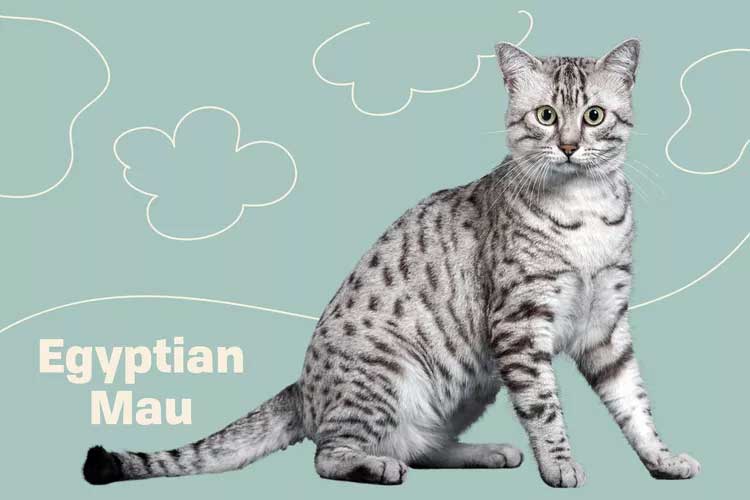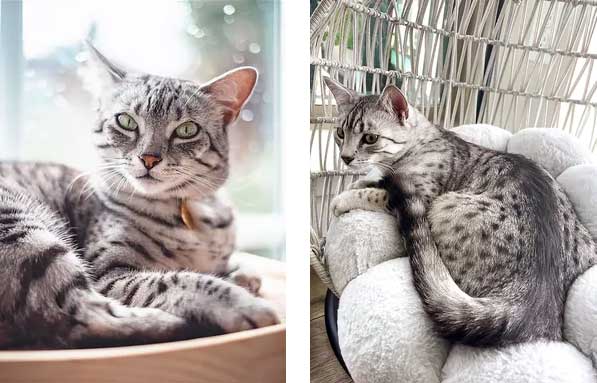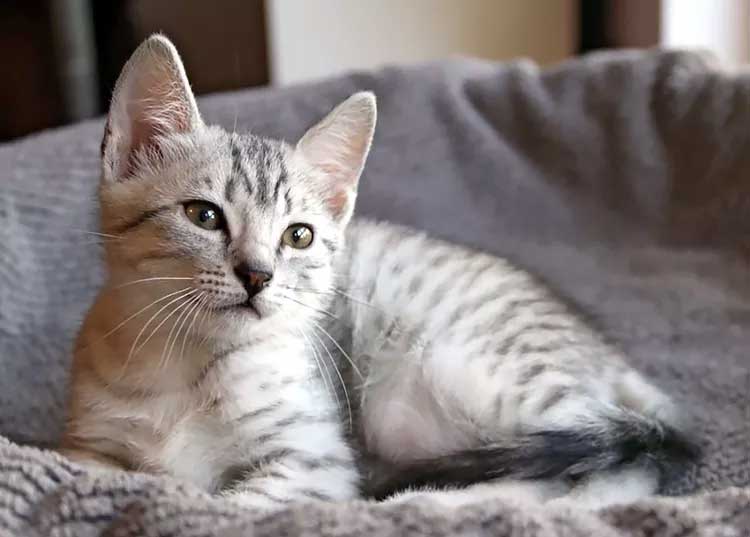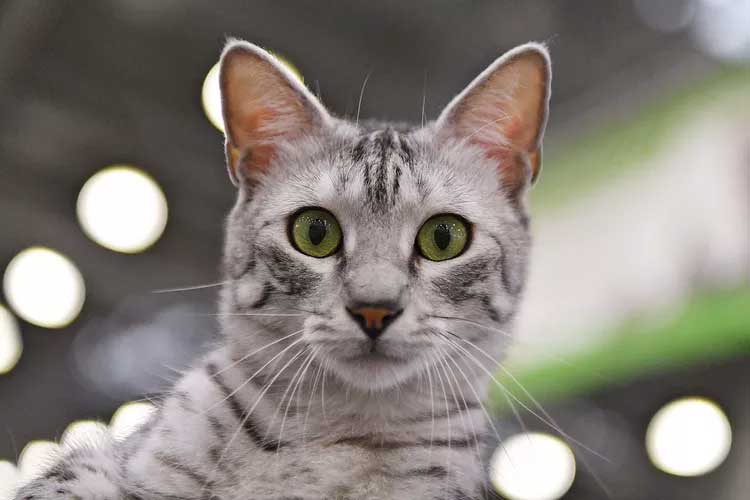The elegantly spotted Egyptian mau is a lean, athletic cat with a history dating back at least 3,000 years. Regal and intelligent, this rare breed is social and needs to be kept busy.

Egyptian Mau Overview
| OFFICIAL NAME | Egyptian Mau |
| COMMON NAME | Egyptian Mau |
| PET HEIGHT | 7 to 11 inches |
| PET WEIGHT | 8 to 12 pounds |
| LIFESPAN | 9 to 13 years |
| GOOD WITH | cats, children, families, seniors |
| TEMPERAMENT | affectionate, sociable |
| INTELLIGENCE | high |
| SHEDDING AMOUNT | normal |
| PLAYFULNESS | high |
| ENERGY LEVEL | active |
| VOCAL LEVEL | when necessary |
| COAT LENGTH | short |
| COLORS | black / ebony, blue / gray, chocolate / brown / sable, lavender / silver |
| PATTERNS | tabby |
| OTHER TRAITS | easy to groom, friendly toward humans, strong loyalty tendencies |
When you see cats depicted in ancient Egyptian art, you're looking at the more-or-less direct-line ancestor of the Egyptian mau. As cats with a noble heritage and an appearance that's reminiscent of an ancient past, the Egyptian mau is the only naturally occurring breed of spotted domestic cat recognized by the Cat Fanciers Association (CFA).
Striking to look at and as beautiful as she is rare, the Egyptian mau is a breed that stirs the imagination with her shiny, spotted coat and gorgeous, gooseberry green eyes.
Appearance
Much like the ocicat, the Egyptian mau is noteworthy for her spotted coat. Unlike the ocicat, however, the mau wasn't created by a breeder. Instead, the Egyptian mau came about her spots naturally.
These long, lean, muscular cats have a true athlete's build. Their hind legs are slightly longer than their front legs, giving them the appearance of standing on tiptoes when they're standing straight up. Those long hind legs, coupled with an additional flap of skin that runs from their flank to their back knees, make them incredible jumpers and the fastest of the domestic cat breeds.
In lieu of traditional tabby markings, the mau is blessed with those famous spots as well as a dark dorsal stripe running from the top of her head to the tip of her tail. Mau coats come in six colors: silver, bronze, smoke, black, caramel, and blue/pewter, with the last three being the rarest. Their heads are slightly oblong and traditionally feature either a "scarab beetle" marking on their forehead or an "M" shape—the latter is more common among North American maus. Their ears are broad based and set fairly wide apart, and their slightly almond-shape eyes are a stunning bright green.
Temperament
The Egyptian mau is a regal, intelligent cat. They are very loyal to their people and often bond most strongly with one particular person, but are affectionate and loving with everyone in their family unit, says Sandra Woodley, chairwoman of The Egyptian Mau Club. She says they can be a little standoffish to strangers at first, but will usually warm up quickly."Generally, they may be a little shy at first and even run and hide," Woodley says. "But given time, they will soon be approaching the stranger for a cuddle."

Playful Egyptian maus are good with children who know how to properly interact with cats, and this affectionate nature doesn't end with two-legged family members. When she's socialized with other cats and cat-friendly dogs from an early age, an Egyptian mau lives well with four-legged family members as well.
While a mau isn't as chatty as, say, a Siamese, Woodley says these pretty kitties can be very talkative and use a stunning array of sounds. Meows, chirps, whistles, and chortles are all common Egyptian mau vocalizations. Maus also have a peculiar act when they are excited: Colloquially referred to as "wiggle tale," they shake their extended tails in a way that resembles spraying or marking territory, though—rest assured—not a drop is being expelled.
"The Egyptian mau makes a wonderful family pet," Woodley says. "They are playful and have an endearing sense of humor, they often learn to retrieve toys thrown for them, and many have an unusual love of water, showing no fear as they stick their heads under a running tap. In a safe environment, they will love going outside. "
Living Needs
If you're looking for a calm lap cat that will snooze in the sun all day, look elsewhere. The most important thing you can do to make your Egyptian mau happy is to provide ways for her to tire herself out. These are athletic, active cats, and they need playtime with their people, cat trees to climb, and cat wheels to run on. Don't be afraid to get your mau out of the house, too—Woodley says these intelligent kitties can be trained to walk on a harness for safe outdoor adventures.
Egyptian maus enjoy being above the action, surveying things from height. So if they aren't provided with a high cat perch like a cat tree, shelf, or hammock, they're likely to make their own on top of a refrigerator or bookshelf.
As social kitties, Egyptian maus need lots of attention from their family. But they are independent enough to do well on their own if you need to be out of the house for extended periods of time. But if you're consistently away from home, look into getting your mau a furry friend to keep her company and stop separation anxiety from forming. If she doesn't get enough attention and playtime, your Egyptian mau might start scratching your furniture or knocking cups of water off of tables to grab your attention!
Care
Egyptian maus shed enough to be excluded from the "hypoallergenic" cats list, but they are also fastidious enough that you don't have to do much in the way of grooming. They are a breed that enjoys being brushed, however. So doing this once or twice a week is a good way to both stay on top of their shedding and orchestrate some special bonding time.
Like all cats, take care when bringing home an Egyptian mau kitten. Make sure she has a warm bed, a clean litter box, and food and water bowls.
"As with any new kitten or cat, they may be a little reserved at first and should be given space to settle in," Woodley says. "It's a good idea to liaise with the breeder around what they have been eating and offer the same to avoid tummy upsets. It's a good idea to use the litterthey are familiar with, asa sudden change could upset your kitten and cause her to avoid the litter tray completely."
Health
The crossbreeding done with the Egyptian mau since the 20th century has done a great job of pushing most common cat ailments to the background, according to the CFA. While still prone to conditions like patellar luxation or periodontal disease as they age, none of them are high-percentage concerns for this breed.To keep your mau in tip-top shape, keep up with regular veterinary appointments. You should also clean her ears, brush her teeth, and trim her nails regularly.

History
The mau is a long-standing Egyptian breed. Much of the ancient Egyptian artwork featuring spotted cats is thought to portray ancestors of today's Egyptian mau, according to The Egyptian Mau Club. While it's impossible to pinpoint where the Egyptian mau came from—theories postulate everywhere from the Nile basin to western Europe—there's no denying that cats strongly resembling the mau have been depicted in art for at least 3,000 years.The cat first came to more widespread attention when exiled Russian princess Nathalie Troubetskoy brought three Egyptian maus with her, first to Italy, then to New York City in 1956. From there, the breed's international reputation grew steadily.
The breed received Championship recognition by the CFA in 1977. While Egyptian maus continue to be popular among show owners and breeders because of their beauty and grace, they remain a rare breed, with only about 200 Egyptian mau kittens registered every year.
Fun Facts
According to the CFA, the word "mau" meant "cat" in ancient Egypt.Egyptian maus are the fastest of all domestic cats, capable of reaching speeds of 30 miles per hour.
Pregnant Egyptian maus have the longest gestation period of all domestic cats, usually around 73 days, according to the CFA.
Thanks to those powerful hind legs, Egyptian maus have been measured jumping as high as 6 feet straight up.